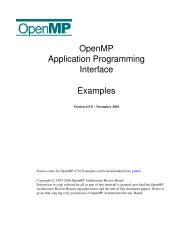D2 3 Computing e-Infrastructure cost calculations and business _models_vam1-final
D2 3 Computing e-Infrastructure cost calculations and business _models_vam1-final
D2 3 Computing e-Infrastructure cost calculations and business _models_vam1-final
Create successful ePaper yourself
Turn your PDF publications into a flip-book with our unique Google optimized e-Paper software.
e-‐FISCAL: www.efiscal.eu <br />
EC Contract Number: 283449 <br />
Please indicate the period in number of years that corresponds to the average useful economic life <br />
(depreciation period) of the following assets according to the policy followed by the NGI site/ HPC Centre. <br />
Answer Options Min Max Average Median <br />
Average useful life in years for CPUs 3 10 4.9 5 <br />
Average useful life in years for tape storage devices 3 12 6.5 5 <br />
Average useful life in years for disk storage devices 3 20 5.6 5 <br />
Table 20: Useful life information<br />
Analysing Table 20 allows us to make an interesting observation. Typically the Total Cost of Ownership (TCO) <br />
exercises use primarily a four year duration (e.g. Walker (2009) <strong>and</strong> Magellan report (2011) <strong>and</strong> sometimes a <br />
three year duration (e.g. Nazir <strong>and</strong> Sørensen (2010)) – as the useful lifetime of a CPU. In our sample the median <br />
useful life to calculate annual depreciation is five years. This has a non-‐negligible impact on the capital <strong>cost</strong>s <br />
accounted each year in order to form the total yearly <strong>cost</strong>. It also has significant effects on electricity consumption <br />
as older machines consume more electricity. Nevertheless, there are instances of long depreciation periods which <br />
will require deeper study to underst<strong>and</strong> the underlying conditions that permit such a treatment. <br />
Cost relations over investment <br />
In order to assess several other <strong>cost</strong> parameters that are related to CAPEX but at the same time are not easily <br />
identifiable <strong>and</strong> measurable, we asked respondents to provide indications on their relative size compared to the <br />
computing <strong>and</strong> storage investment. As these estimations were expected to be rough, respondents were given the <br />
flexibility instead of identifying a sole number (in our case percentage) to indicate a range of values (e.g. between <br />
10%-‐20%). Therefore the following numbers are considered as high-‐level approximations. <br />
Estimated <strong>cost</strong> relations of several parameters on computing <strong>and</strong> hardware storage <br />
Min Max Average Median <br />
Please present an overall estimation of the related <br />
interconnect equipment <strong>cost</strong>s (network devices, cables, etc.) <br />
as a percentage of the hardware acquisition <strong>cost</strong>* 0% 30% 10% 9% <br />
Please present an overall estimation of the support contract <br />
<strong>cost</strong>s (e.g. next-‐<strong>business</strong>-‐day hardware support <strong>cost</strong>s) as a <br />
percentage of the hardware (CPUs <strong>and</strong> storage devices) <br />
acquisition <strong>cost</strong> ** 0% 25% 6% 4% <br />
If you were to equip the existing NGI site/ HPC Centre now <br />
what would be the investment <strong>cost</strong> of all auxiliary equipment <br />
as percentage of the <strong>cost</strong> of acquiring computing <strong>and</strong> <br />
hardware storage capacity*** 5% 35% 18% 20% <br />
Please make an estimation of the total <strong>cost</strong> of the related <br />
software (e.g. operating system, fabric layer / file system <br />
software (e.g. LSF, GPFS), software support contract <strong>cost</strong>s, <br />
applications <strong>cost</strong>, 3rd party software <strong>cost</strong>, compilers, etc.) as <br />
a percentage of the hardware (CPUs <strong>and</strong> storage devices) <br />
acquisition <strong>cost</strong> 0% 15% 4% 2% <br />
e-‐FISCAL : Financial Study for Sustainable <strong>Computing</strong> e-‐<strong>Infrastructure</strong>s <br />
Deliverable <strong>D2</strong>.3 – <strong>Computing</strong> e-‐<strong>Infrastructure</strong>s <strong>cost</strong> estimation <strong>and</strong> analysis – Pricing <strong>and</strong> <br />
Business <strong>models</strong> <br />
87




